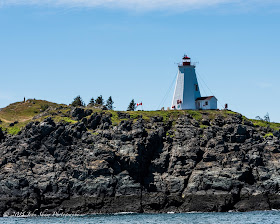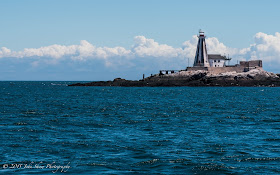The site chosen was the east side of 360-acre Pond Island. The small freshwater pond that gave the island its name, now mostly a swamp, is at the its northern end. Three acres of land for the light station were purchased for $270 from Benjamin C. Stanwood, who operated a farm on the island. The entire island had been in the Stanwood family since 1833, when it was bought from a Boston doctor.
Narraguagus Light Station, established in April 1853, originally consisted of a tower and lantern in atop the center of a keeper’s dwelling. The first keeper was Joseph Brown. A fifth-order Fresnel lens replaced the original system of multiple lamps and reflectors in 1856. The focal plane of the light was 54 feet above mean high water.
In 1875, the Lighthouse Board reported that the dwelling had become uninhabitable. A new five-room dwelling was built in 1876, and much of the original house was removed from around the tower. Around the same time, a ten-sided lantern and a new deck were installed, and a hand-rung fog bell was established.
The 31-foot granite tower was connected to the dwelling by a workroom built from part of the original house in 1887. The rest of the original dwelling was removed at the same time.
A barn and a fuel house, as well as a cistern in the dwelling’s cellar, were added in 1892. In 1894, the lighthouse was reinforced with a layer of brick, and a new lantern deck and interior iron stairway were installed along with an iron stairway inside the tower.
Access to the station was difficult, requiring a half-mile walk across the island. A boat slip built near the lighthouse in 1900 was for emergency access to the island only and was not used by the keepers. Few of the station's keepers stayed more than a few years until William C. Gott, who arrived in 1893 and stayed until at least 1915.
An inn and clubhouse was were built on the island in 1878, and the three-story Pond Island House continues to operate today. A golf course was added to the island in the 1920s. According to Anne C. Nash’s book Pond Island Heritage, visiting the lighthouse keeper and his family was a typical summer activity for guests at the Pond Island House, when they weren’t busy playing golf or croquet, or competing in wheelbarrow races.
According to Nash, Elizabeth Hitchcock, an island resident, recalled girlhood visits with the Gott family at the lighthouse. “I would go to see the keeper’s tall, slender, red-haired wife,” she recalled. “She seemed always to be baking biscuits or yeast bread, and the kitchen smelled of bread, kerosene, and fresh paint.”
One day, Keeper Gott was away fishing on the west side of the island when the lighthouse inspector’s boat appeared. Young Elizabeth, knowing a surprise inspection was imminent, ran to tell the keeper. She took along his uniform, which he donned as he hurried through the woods to the light station. He emerged from the woods in full uniform just as the inspector reached the station.
Elizabeth Hitchcock also recalled Sunday evening hymn-singing sessions with the Gotts. Elizabeth’s mother played the organ while everyone sang loudly. “Mrs. Gott wouldn’t sing,” Elizabeth remembered, “but tears would roll down her cheeks. She was so happy to have friends come in the summer time. The winters were so lonely.”
In 1886, Lucy Brown Reynolds described a visit to the light station during Gott's stay in her book Drops of Spray from Southern Seas:
It was a dark, stormy night, and the keeper's cottage was very cheerful, with its glow of lamp and firelight. A capital supper having been partaken of, we were shown over the lighthouse by the keeper's wife, a cheery, bustling little woman, who seemed delighted to have us there. I had never been inside a lighthouse tower before, and was very much interested in all I saw. The brilliant light sent its warning far out over the troubled waters, bidding all mariners beware. At intervals we could hear the boom, boom, of the steam foghorn at Petit Manan, three miles or thereabouts outside.
On August 4, 1929, a Nova Scotia schooner, en route to Salem and Boston, Massachusetts, was wrecked on Petit Manan Bar in a gusty rainstorm. The two keepers at Petit Manan Light Station attempted to aid the crew, but they found that the vessel had already been abandoned.
The captain and three crewmen escaped in the schooner’s rowboat and took refuge at the Narraguagus Light Station, where the keeper, Charles E. Tracy, cared them for them for 12 days. On August 16 they left in the rowboat for a 95-mile journey to Nova Scotia, with food provided by Tracy. The British consul general at Boston wrote a letter expressing his thanks for the services of Tracy and the two keepers at Petit Manan Light.
Narraguagus Light was discontinued in 1934, and the lighthouse and other buildings and the surrounding five acres were sold at auction to Wilbur Dameron. The property was later inherited by Dameron’s son, Wilbur Jr.
According to Anne C. Nash, the lighthouse has been the scene of much ghostly activity. In the 1970s, two college friends of a member of the Dameron family spent the night in a downstairs bedroom. They reported hearing a woman speaking loudly and angrily in a foreign language during the night. The only woman present in the house, Wilbur Dameron Jr.’s wife, Nancy, spoke only English and claimed she had been asleep all night.
On the following night, one of the young men was aroused by a loud noise next to him, as if something heavy had landed on his pillow. There was nothing on the pillow, and nothing in the room was disturbed. According to Nash, the spirit left the young men alone after they made it clear that they were there to help renovate the house, not to harm it.
The lighthouse and keeper's dwelling remain, as well as the oil house and two storage buildings, still owned privately.
Credits: I would like to thank Jeremy D'Entremont, webmaster of, http://www.newenglandlighthouses.net/, for sharing the above history. Jeremy is a speaker, author, historian, and tour guide who is widely recognized as the foremost authority on the lighthouses of New England. To view a story on him, go to, (Jeremy D'Entremont).









































